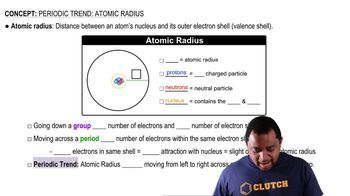Here are the essential concepts you must grasp in order to answer the question correctly.
van der Waals b parameter
The van der Waals b parameter represents the volume occupied by one mole of particles in a gas, accounting for the finite size of the molecules. It is a crucial factor in the van der Waals equation, which describes real gas behavior by incorporating molecular interactions and sizes. The b parameter helps in estimating the effective size of atoms or molecules, which is essential for understanding intermolecular forces.
Recommended video:
van der Waals radius
The van der Waals radius is a measure of the size of an atom or molecule when it is not bonded to another atom. It reflects the distance at which the electron clouds of two nonbonding atoms begin to overlap, indicating the effective size of the atom in a nonbonding context. This radius is important for understanding molecular interactions, particularly in gases and liquids where atoms are not held together by covalent bonds.
Recommended video:
bonding vs. nonbonding atomic radius
Bonding atomic radius refers to the size of an atom when it is involved in a chemical bond, typically smaller due to the influence of electron sharing or transfer. In contrast, nonbonding atomic radius, such as the van der Waals radius, describes the size of an atom when it is not participating in bonding interactions. Understanding the distinction between these radii is essential for interpreting molecular structures and interactions in various states of matter.
Recommended video:



